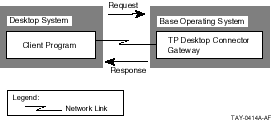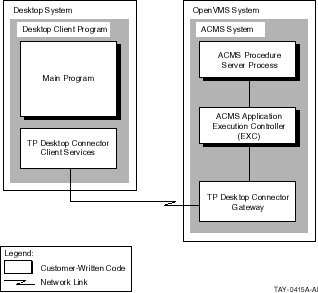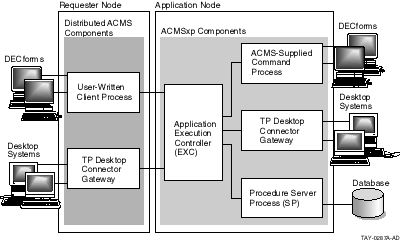The information in this publication is subject to change without notice.
COMPAQ COMPUTER CORPORATION SHALL NOT BE LIABLE FOR TECHNICAL OR EDITORIAL ERRORS OR OMISSIONS CONTAINED HEREIN, NOR FOR INCIDENTAL OR CONSEQUENTIAL DAMAGES RESULTING FROM THE FURNISHING, PERFORMANCE, OR USE OF THIS MATERIAL. THIS INFORMATION IS PROVIDED "AS IS" AND COMPAQ COMPUTER CORPORATION DISCLAIMS ANY WARRANTIES, EXPRESS, IMPLIED, OR STATUTORY, AND EXPRESSLY DISCLAIMS THE IMPLIED WARRANTIES OF MERCHANTABILITY, FITNESS FOR PARTICULAR PURPOSE, GOOD TITLE, AND AGAINST INFRINGEMENT.
This publication contains information protected by copyright. No part of this publication may be photocopied or reproduced in any form without prior written consent from Compaq Computer Corporation.
ACMS, ACMS Desktop, DEC, DECforms, DECnet, DECnet-DOS, DECtp, DECtrace, DECwindows, OpenVMS, PATHWORKS, VAX, VAX DOCUMENT, VAXcluster, VAXset, VMS, VT, and the DIGITAL logo are trademarks of Compaq Computer Corporation.
Apple, AppleTalk, HyperCard, HyperTalk, Macintosh, and MacTCP are registered trademarks of Apple Computer, Inc.
4D, 4D External Kit, and 4th Dimension are registered trademarks or trademarks of ACI and ACIUS, Inc.
Hayes is a registered trademark of Hayes Microcomputer Products, Inc.
InterConnections, Inc., Terminal Emulation Services, TES, Network Print Services, NPS, and DECnet/IPX Portal are trademarks of InterConnections, Inc.
Microsoft, Microsoft C, Microsoft COBOL, MS, MS-DOS, Visual Basic, Windows, Windows 95, Windows 98, and Windows NT are registered trademarks of Microsoft Corporation.
Motif and OSF/Motif are registered trademarks of The Open Group in the United States and other countries.
Novell and NetWare are registered trademarks of Novell, Inc.
Open Desktop and SCO are trademarks of Santa Cruz Operation, Inc.
OPEN LOOK is a registered trademark of UNIX System Laboratories, Inc., a wholly owned subsidiary of Novell, Inc.
Oracle CDD and Oracle Rdb are registered trademarks of Oracle Corporation.
PowerBuilder is a registered trademark of PowerSoft Corporation.
X Window System is a registered trademark of Massachusetts Institute of Technology.
Other product names mentioned herein may be trademarks and/or registered trademarks of their respective companies.
This document is available on CDROM.
This document was prepared using VAX DOCUMENT, Version V3.2-1n.
| Contents | Index |
For ACMS developers:
| Part 1 | Components and Design |
|---|---|
| Chapter 1 | Describes the components of the software and the basic processing that is performed. |
| Chapter 2 | Explains the design essentials. |
| Chapter 3 | Describes the development to be done on the OpenVMS system. |
| Part 2 | Portable API and Macintosh Client Development |
| Chapter 4 | Describes the steps to code, debug, and build a desktop client program that uses TP Desktop Connector client services in a DOS blocking environment. |
| Chapter 5 | Describes the steps to code, debug, and build a desktop client program that uses TP Desktop Connector client services in a Windows, Windows 95, Windows 98, or Windows NT event-driven nonblocking environment. |
| Chapter 6 | Describes the stages to code, debug, and build a desktop client program that uses TP Desktop Connector client services in a Motif, event-driven, nonblocking environment on OpenVMS |
| Chapter 7 | Discusses guidelines for building TP Desktop Connector for ACMS client programs using the forced nonblocking client services. |
| Chapter 8 | Describes the steps to code, debug, and build a desktop client program in a Macintosh environment. |
| Appendixes | |
| Appendix A | Lists the locations of code that accompanies the TP Desktop Connector software. |
| Appendix B | Lists the general purpose tools, include files, and sample programs in the ACMSDI$EXAMPLES directory. |
| User Input | In examples, user input is differentiated in boldface type from system output. |
| $ | The dollar sign indicates a generic command line prompt. This prompt may be different on your system. |
| [Return] | A key name in a box indicates that you press that key on the keyboard. |
| [Ctrl/x] | Press the Ctrl (control) key and hold it down while pressing the specified key (indicated here by x). |
| WORD | Uppercase text indicates OpenVMS data types, commands, keywords, logical names, and routines or services; C files and data structures; Microsoft Windows data structures; and HyperCard data types. |
| word | In format descriptions, a lowercase word indicates parameters, variables, and services or procedures. |
| italics | Italic type is used for emphasis and for parameters in text. Titles of manuals are also italicized. |
| [] | In format descriptions, square brackets surround a choice of options; select none, one, several, or all of the choices. |
| .
. . |
A vertical ellipsis in an example means that information not directly related to the example has been omitted. |
| TP Desktop | Refers to Compaq TP Desktop Connector for ACMS software. |
| CDD | Refers to the Oracle CDD product. |
| Rdb | Refers to the Oracle Rdb product. |
| Windows | Refers to Microsoft Windows, Microsoft Windows 95, Microsoft Windows 98, or Microsoft Windows NT. |
The following sections discuss the TP Desktop Connector Gateway for ACMS. See Compaq TP Desktop Connector for ACMS Gateway Management Guide for a description of system management tasks and transports.
Figure 1-1 TP Desktop Components

You write desktop client programs to run on desktop systems using the TP Desktop Connector client services. Through the TP Desktop client services, these desktop client programs send requests to and receive responses from the ACMS system. The TP Desktop client services and the embedded network software on the desktop system allow the desktop system to transmit and receive TP Desktop Connector messages over a communications medium.
The desktop client program communicates with an ACMS system through the TP Desktop Connector Gateway for ACMS shown in Figure 1-1. The TP Desktop client services call the TP Desktop Connector Gateway for ACMS to execute requests. As an ACMS agent, the TP Desktop Connector gateway communicates with other ACMS components for the desktop client program and sends the results of requests back through the mutually understood interface.
Access through TP Desktop software to an ACMS system requires a software configuration similar to that shown in Figure 1-2. Although your system need not be exactly the same as the one shown, your system must have at least:
Figure 1-2 TP Desktop Configuration

The TP Desktop portable client services support the following operating systems:
The TP Desktop client services for Macintosh support a Data Access Manager interface. Macintosh clients can also perform I/O tasks.
Although network software is required for TP Desktop software to work, the programmer does not need to understand networking to develop desktop client programs. The network software is largely transparent to the desktop client program. The TP Desktop client services shield the desktop client program from both the message protocol used by TP Desktop software and the networking services used to implement that protocol.
To communicate, both the TP Desktop Connector gateway and the desktop systems using TP Desktop software must have the appropriate network software installed. For example, DOS can use either a DECnet or a Novell NetWare 1 transport. The user or system manager must install this software and ensure that a network connection links the desktop client program to the TP Desktop Connector gateway.
TP Desktop transparently handles all the network communications necessary to call ACMS tasks running on an OpenVMS system.
Table 1-1 lists the transports TP Desktop supports on OpenVMS VAX Version 5.5-2, Version 6.1, Version 6.2, and Version 7.1.
Table 1-2 lists the transports TP Desktop supports on OpenVMS Alpha Version 6.1, Version 6.2, and Version 7.1.
The TP Desktop Connector gateway handles user sign-in and is responsible for invoking tasks. The EXC calls the TP Desktop Connector gateway to handle exchange steps, passing the same type of workspaces and other data to the TP Desktop Connector gateway that it passes to the Command Process (CP).
The TP Desktop Connector gateway fulfills these roles:
Figure 1-3 TP Desktop-Oriented Components

For efficiency, the TP Desktop Connector gateway runs as a multithreaded process. It can handle multiple desktops and multiple requests simultaneously. The capacity is controlled by factors such as the maximum network links available on the OpenVMS system, and the licensing scheme. Like all ACMS processes, the TP Desktop Connector gateway is started before any user activity is requested. This prestarting takes care of all overhead activities before a user request is received. The TP Desktop Connector gateway design ensures effective use of resources, with optimal throughput and response time.
Because the TP Desktop Connector gateway complements the Command Process (ACMS CP), using TP Desktop software has no impact on the rest of the ACMS system. As shown in Figure 1-3, the TP Desktop Connector gateway and the CP can run on the same system. The ACMS application, task group, and task definitions, and the server procedures that support a VT terminal can be used unchanged from a desktop system having TP Desktop software.
VT terminals and desktop systems can use a single runtime instance of an ACMS application simultaneously. The desktop systems use their own presentation procedures, while the VT terminals use DECforms form I/O or TDMS request I/O. The DECforms and TDMS runtime libraries are not used on the desktop system.
The implementation of the TP Desktop Connector gateway as a complement to the CP ensures that the benefits of the ACMS runtime system are retained. This includes the efficient processing provided by the ACMS runtime system and the capabilities that ACMS software supplies in application control, availability, resource management, event-tracking, and task-level security. TP Desktop Connector software allows you to take full advantage of the unique benefits of both the desktop system and the ACMS software environment.
1 TP Desktop supports Novell NetWare as a transport over a local area network (LAN). |
| Next | Contents | Index |